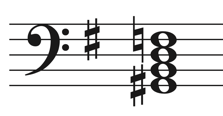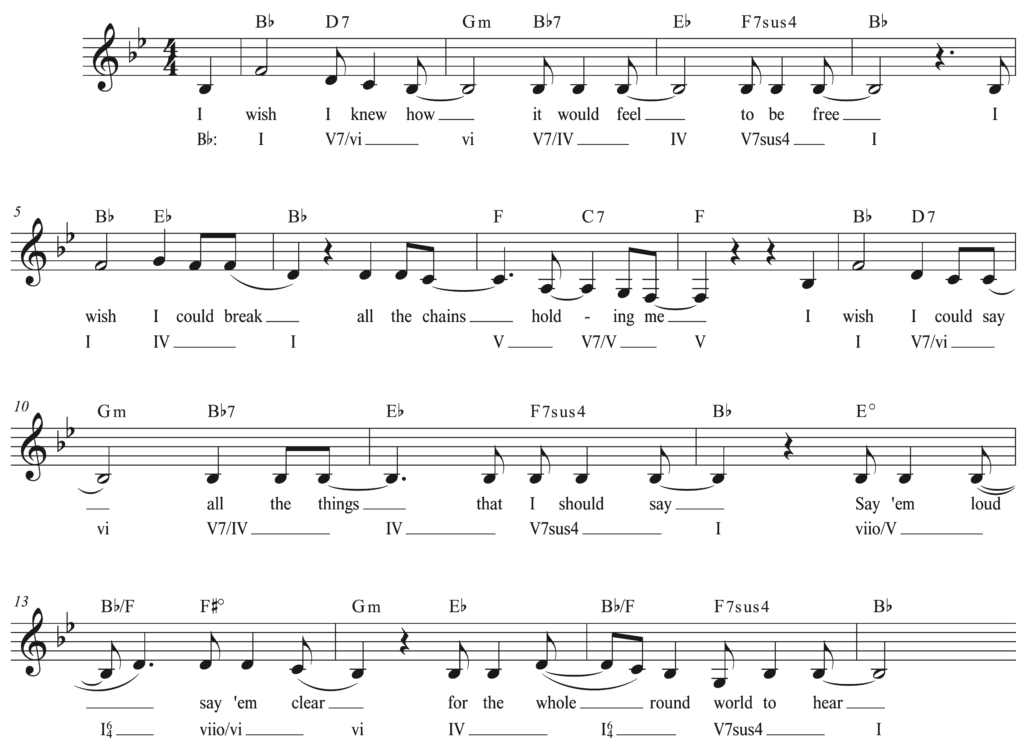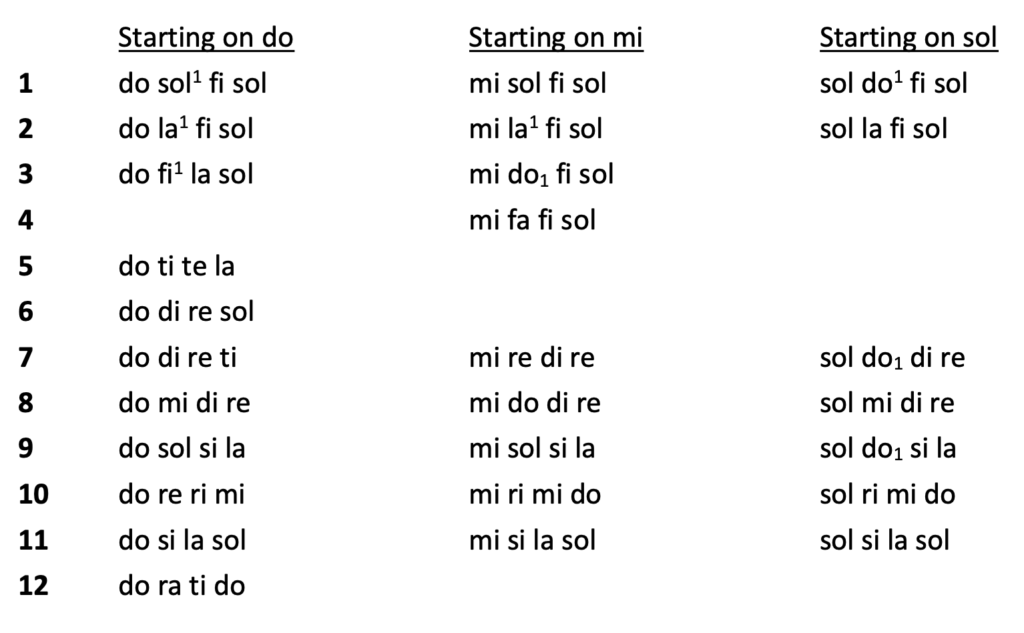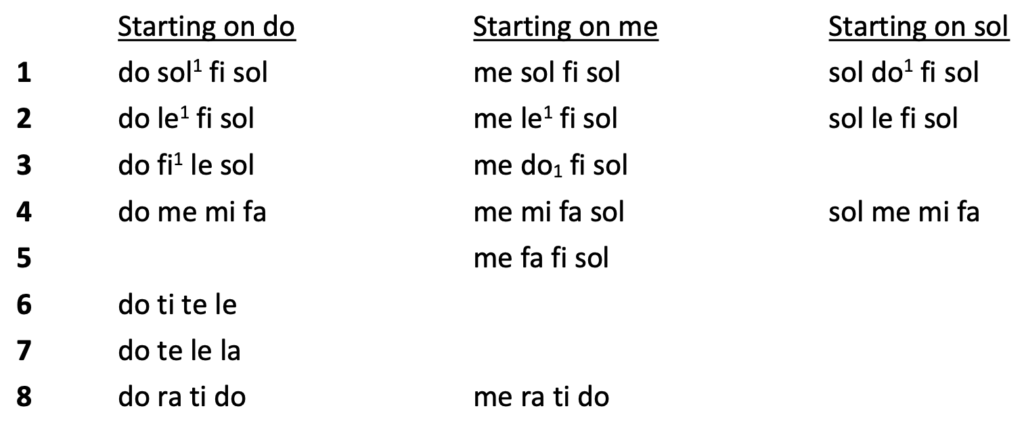Main Body
32 Secondary diminished chords
Learning goals for Chapter 32
In this chapter, we will learn:
- How to spell
- How to identify secondary diminished chords in context
Secondary diminished chords
Just as tonicize any non-tonic major or minor triad, so do , which are built on the of the tonicized key. Like secondary dominants, secondary diminished chords can be triads or seventh chords, and they may appear in any inversion.
Some common secondary diminished chords are shown in the progressions in Example 32‑1 and Example 32‑2. After listening to each example, provide a Roman numeral analysis. The first four chords are completed for you in Example 32‑1.
Example 32‑1. Secondary diminished chords in major
Example 32‑2. Secondary diminished chords in minor
Spelling secondary diminished chords
Follow these steps for success in spelling secondary diminished chords:
Step 1. Identify the root of the chord that is to be tonicized.
Step 2. For a moment, disregard the tonic key.
Step 3. Identify the leading tone of the temporarily tonicized key identified in step 1. It may be helpful to remember that the secondary leading tone is always a diatonic half step below the temporary tonic. This is the of the secondary diminished chord.
Step 4. Given the root identified in step 3, spell a diminished chord, which will be a triad or seventh depending on the specified quality.
Step 5. Consider the overall tonic key once again, adding accidentals as needed, when spelling the chord rendered in step 4. If the chord is inverted, be sure to put the proper chord tone in the bass.
Figure 32-1 illustrates how to work through the process of spelling the viio7/ii in G major.
Figure 32‑1. Illustration of spelling a secondary diminished chord
Goal: to spell the viio7/ii in G major.
- In G major, the root of the ii chord is A.
- Temporarily disregard the key of G major.
- The secondary leading tone of A is G
 .
. - Since a fully diminished seventh chord is specified, the chord is spelled entirely with minor thirds: G
 B D F
B D F .
.
Spelling the chord in G major would look like this:

Video: T59 Secondary diminished chords (12:03)
This interactive video introduces the concept of secondary diminished chords, which are built on the secondary leading tone of the tonicized major or minor triad. We study two chord progressions, one in major and another in minor (Example 32‑1 and Example 32‑2), labeling each secondary chord and listening to how they sound in the context of each progression.
Secondary chords in context
Example 32‑3 features several secondary chords. The first, a secondary diminished seventh chord (B![]() dim. 7), occurs in m. 5 and tonicizes the supertonic triad that follows in the next measure. A secondary dominant (B7) tonicizing the subdominant triad occurs in mm. 10 and 14. Both of these chords contain notes outside of the home key of B major.
dim. 7), occurs in m. 5 and tonicizes the supertonic triad that follows in the next measure. A secondary dominant (B7) tonicizing the subdominant triad occurs in mm. 10 and 14. Both of these chords contain notes outside of the home key of B major.
Example 32‑3. Transcription of Beyoncé, “Pray You Catch Me,” 1:28–2:08
Listen to the full track on Spotify.
Learn about Beyoncé (b. 1981) by reading this Oxford Music Online article, written by Mark Anthony Neal.
Similarly, Example 32‑4 features many compelling secondary chords. In mm. 1 and 9, a secondary dominant tonicizes the submediant triad. In mm. 2 and 10, a secondary dominant tonicizes the subdominant chord. In m. 7, a secondary dominant tonicizes the dominant triad. Secondary diminished triads built on scale degree ![]() [latex]\hat{4}[/latex] (fi) in mm. 12 and 14 tonicize dominant function, as each resolves to a . And in m. 13, a secondary diminished chord tonicizes the submediant chord.
[latex]\hat{4}[/latex] (fi) in mm. 12 and 14 tonicize dominant function, as each resolves to a . And in m. 13, a secondary diminished chord tonicizes the submediant chord.
Example 32‑4. Transcription of Nina Simone singing Billy Taylor, “I Wish I Knew How It Would Feel to Be Free,” 0:32–1:04
Listen to the full track on Spotify.
Learn about American singer, pianist, and activist Nina Simone (1933–2003) by reading this Oxford Music Online article, written by Mark Anthony Neal.
Learn about American jazz pianist and composer Billy Taylor (1921–2010) by reading this Oxford Music Online article, written by Bill Bennett.
EXERCISE 32-1 Spelling secondary chords
Spell the secondary dominants and diminished chords below. For each problem, provide the key signature of the tonic key and spell the chord using accidentals as needed.
SET 1
SET 2
SET 3
EXERCISE 32-2 Analysis with secondary chords
PART A. After studying and listening to Worksheet example 32‑1, identify the key, provide a Roman numeral analysis, and circle and label by type all and . Then create a form (bubble) diagram showing measure numbers, cadences, and phrase labels with lowercase letters, and answer the question that follows. To review how to create a form (bubble) diagram, see Chapter 19.
Worksheet example 32‑1. Ludwig van Beethoven, Sonatina no. 37 in G major, mvt. 2, mm. 1–8
Listen to the full track, performed by pianist Jenö Jandó, on Spotify.
Learn about German composer Ludwig van Beethoven (1770–1827) by reading this Oxford Music Online article, written by Joseph Kerman and others.
Question: What two-word phrase best describes the form of Worksheet example 32‑1, and why?
PART B. After studying and listening to Worksheet example 32‑2, identify the key and provide a Roman numeral analysis. All non-chord tones are circled in this example. Label each by type. Finally, circle and label all by type.
Worksheet example 32‑2. Maria Wolowska Szymanowska, Nocturne, mm. 1–5
Listen to the full track, performed by pianist Nancy Fierro, on Spotify.
Learn about Polish pianist and composer Maria Wolowska Szymanowska (1789–1831) by reading this Oxford Music Online article, written by Zofia Chechlińska.
Chromatic pitch patterns
Example 32‑5 shows the solfege syllables for all chromatic pitches, which we first encountered in Chapter 6. Enharmonically equivalent notes have different syllables depending on if the scale degree is raised or lowered. In general, raised chromatic notes use a “long e” /i/ vowel sound, and lowered chromatic notes use a “long a” /eI/ vowel sound (with the exception of “ra,” lowered scale degree ![]() , which we encountered in the scale).
, which we encountered in the scale).
Video: S32 Chromatic solfege syllables (3:10)
This interactive video introduces the movable-do syllables and hand signs for the chromatic scale, with the tonic of B![]() .
.
Practice singing, playing, and aurally identifying the pitch patterns that appear below in Figure 32‑2 (pitch patterns in major) and Figure 32‑3 (pitch patterns in minor) in various keys. In cases that may seem ambiguous, superscripts (1) indicate a pitch in the higher octave (above the previous note), while subscripts (1) indicate a pitch in the lower octave (below the previous note).
Figure 32‑2. Chromatic pitch patterns in major
Figure 32‑3. Chromatic pitch patterns in minor
Self-quiz on solfege thinking problems
chords built on a secondary leading tone that tonicize any non-tonic major or minor triad
any chord that temporarily functions as a dominant to a diatonic major or minor chord that is not tonic
in a secondary dominant chord, the leading tone of the tonicized key
the fundamental note from which a chord is built
term referring to notes outside of a key
type of second inversion triad that has scale degree 5 in the bass and resolves to a dominant chord, extending dominant function, usually at a cadence
triad in second inversion, meaning the fifth of the chord is the lowest sounding note
notes that do not belong in a given chord; for example, D would be a non-chord tone in relationship to a C major triad
scale that features the following interval pattern: half - whole - whole - whole - half - whole - whole
system of associating pitches with syllables, also referred to as "solmization"; with movable-do solfege, the major scale uses "do," "re," "mi," "fa," "sol," "la," and "ti," and "do" is always tonic; with fixed-do solfege, "do" is always C











